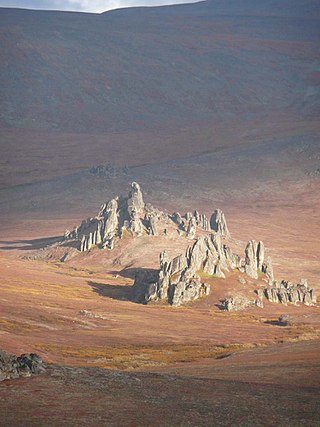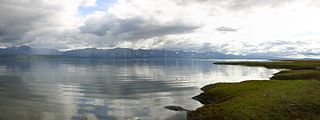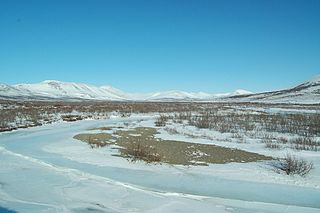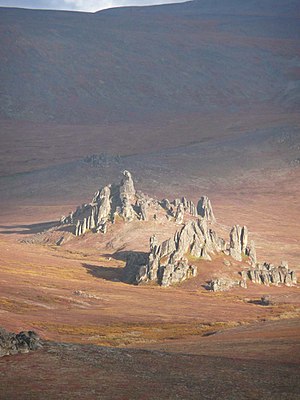
The Seward Peninsula is a large peninsula on the western coast of the U.S. state of Alaska whose westernmost point is Cape Prince of Wales. The peninsula projects about 200 mi (320 km) into the Bering Sea between Norton Sound, the Bering Strait, the Chukchi Sea, and Kotzebue Sound, just below the Arctic Circle. The entire peninsula is about 210 mi (330 km) long and 90–140 mi (145–225 km) wide. Like Seward, Alaska, it was named after William H. Seward, the United States Secretary of State who fought for the U.S. purchase of Alaska.

The Unalakleet River in the U.S. state of Alaska flows southwest 90 miles (145 km) from the Kaltag Mountains to near the town of Unalakleet, on Norton Sound of the Bering Sea.

The Dolly Varden trout is a species of salmonid fish native to cold-water tributaries of the Pacific Ocean in Asia and North America. It belongs to the genus Salvelinus, or true chars, which includes 51 recognized species, the most prominent being the brook, lake and bull trout, as well as Arctic char. Although many populations are semi-anadromous, fluvial and lacustrine populations occur throughout its range. It is considered by taxonomists as part of the Salvelinus alpinus or Arctic char complex, as many populations of bull trout, Dolly Varden trout and Arctic char overlap.

The Bering Land Bridge National Preserve is one of the most remote Protected areas of the United States, located on the Seward Peninsula. The National Preserve protects a remnant of the Bering Land Bridge that connected Asia with North America more than 13,000 years ago during the Pleistocene ice age. The majority of this land bridge now lies beneath the waters of the Chukchi and Bering Seas. During the glacial epoch this bridge was a migration route for people, animals, and plants whenever ocean levels fell enough to expose the land bridge. Archeologists disagree whether it was across this Bering Land Bridge, also called Beringia, that humans first migrated from Asia to populate the Americas, or whether it was via a coastal route.

The Kiwalik River is a stream on the Seward Peninsula in the U.S. state of Alaska. The headwaters of the river originate in the eastern portion of the peninsula, around Granite Mountain. The river flows north to its mouth at Kiwalik Lagoon, Chukchi Sea. The start of the 20th century mining town of Candle is found on its western bank at the confluence of Candle Creek. The ore minerals and materials found in the river basin are galena, gold, pyrite, scheelite, silver and sphalerite, and the primary commodities are tungsten, lead and zinc.

The Imuruk Basin is an approximately 90 sq mi (230 km2), 17 mi (27 km) long shallow estuary located on the Seward Peninsula in the U.S. state of Alaska. The estuary's drainage basin covers about one quarter of the peninsula. The basin is fed by the Kuzitrin, Kruzgamepa, Agiapuk, and Cobblestone Rivers and is drained by the Tuksuk Channel, which empties into Grantley Harbor.

The Fish River is a waterway in the U.S. state of Alaska. The 47-mile-long (76 km) river rises in the Bendeleben Mountains and flows south to Golovnin Lagoon, before emptying into Golovnin Bay, Norton Sound, and the Bering Sea. The basin formed by the Fish River is known for its placer gold deposits, and in particular, the Niukluk River and its tributaries; production from this tributary valley is reported to be more than from any other place in the region. A galena mine existed 40 miles (64 km) from the sea, worked on occasion by a San Francisco corporation with a few hundred tons of ore taken to the city for smelting and refining for silver. Walter Curran Mendenhall found obscure fossils on Fish River at White Mountain.
The Tubutulik River is a waterway in the U.S. state of Alaska. The 25-mile (40 km) long river is situated on the Seward Peninsula. It flows southeastwards to the Kwiniuk Inlet at the northwestern end of Norton Bay, 25 miles (40 km) southwest of Koyuk in the Bering Sea. Its Inuit name was reported as "Tubuktulik" in 1849 by Capt. Mikhail Dmitrievich Tebenkov of the Imperial Russian Navy. Exploration for placer gold occurred in the Council district area where the river valley is located, and in 1898, mining commenced. The production was substantial and ranked second only to that of Nome.

The Bendeleben (/ˈbɛn.dəˌleɪ.bɨn/) Mountains are a mountain range on the heart of the Seward Peninsula in Nome Census Area, Alaska, United States. This range forms a major divide between drainage basins draining into the Pacific Ocean and the Arctic Ocean. The tallest peak, Mount Bendeleben is 3,730 feet (1,140 m) at the summit, and is located on the west end. Bits of the range go into the Bering Land Bridge National Preserve, but most of the peaks remain unclaimed. The Tubutulik River flows in the area.
The Kruzgamepa River is a 55-mile (89 km) tributary of the Kuzitrin River on the Seward Peninsula in the U.S. state of Alaska. The river begins at Salmon Lake, elevation 447 feet (136 m), and descends to 20 feet (6.1 m) above sea level at its mouth. In turn, the Kuzitrin River empties into the Imuruk Basin. The basin drains via the bay of Port Clarence to the Bering Sea.
Eldorado River is a waterway on the Seward Peninsula in the U.S. state of Alaska. It is situated 14 miles (23 km) west of Solomon. This river has its source within a few miles of Salmon Lake, from which it is separated by a low divide. It flows southeast through a broad gravel-filled valley for 30 miles (48 km) to Flambeau River before emptying into Safety Sound. Its headwaters reach the limestones of the Nome series and much of its course lies in a chlorite-albite-schist belt. The Eldorado River provides a southerly drainage into the Bering Sea.
Flambeau River is a waterway on the Seward Peninsula in the U.S. state of Alaska. It has a broad, basin-shaped valley, and terminates as a tributary to Safety Sound. Its name is first recorded by Edward Chester Barnard of the United States Geological Survey (1900). The nearby gold prospect deposit site, "Flambeau River", is named after the waterway.

York Mountains are located on the Seward Peninsula in the U.S. state of Alaska. They extend inland from the Bering Sea to the rocky cape of the same name. On the seaward sides, the streams have incised canyon-like valleys. Eastward, the York Mountains are extended by the highlands lying north of Port Clarence. Their western flanks fall off rather abruptly to the York PIateau. The general aspect of these mountains is rugged. The York Mountains and several other highland masses form isolated groups in the northern half of the peninsula, while in the southern half of the peninsula, the Kigluaik, Bendeleben, and Darby mountains form a broken range along a crescentic axis.
Bonanza River (Inupiaq: Kiwaliq) is a waterway on the Seward Peninsula in the U.S. state of Alaska. The headwaters lie close to Venetia Creek and the Koksuktapaga River. It flows southeast for 25 miles (40 km) before reaching Safety Sound, as do the Flambeau and Eldorado Rivers, and then through Safety Inlet to Norton Sound. The village of Solomon is approximately 2 miles (3.2 km) away. Across the divide of West Creek, in the Bonanza River drainage, and lying above the West Creek schists, is a series of green chloride schists and sills of greenstone; these chloritic schists are the prevailing rocks of the divide between Eldorado and Bonanza rivers. In its general character, it is similar to the Eldorado River. Also called Bonanza Cal, later maps indicate California Creek to be a principal tributary of Bonanza River. According to Alfred Hulse Brooks, the Eskimo name is Ki-ul-uk.

Nome River is a waterway on the Seward Peninsula in the U.S. state of Alaska. It has its source in a narrow valley in the southern margin of the Kigluaik Mountains, 4.5 miles (7.2 km) west of Salmon Lake.
Cape Mountain (Inupiaq: Kiŋigin) is located 3 miles (4.8 km) southeast of Cape Prince of Wales on the Seward Peninsula in the U.S. state of Alaska. It was named by the surveyor, Alfred Hulse Brooks, in 1900.
Bluestone River is a waterway located on the Seward Peninsula in the U.S. state of Alaska. A tributary of the Tuksuk Channel from the south, Bluestone is a north-flowing stream situated 11 miles (18 km) southeast of Teller. It was named in 1900 by Edward Chester Barnard, topographer of the United States Geological Survey.

Grantley Harbor is a waterway located at the bay of Port Clarence, Alaska, on the Seward Peninsula in the U.S. state of Alaska. The inner harbor at the entrance to the northeast corner of the bay was named after Lord Grantley.

Noxapaga River is a 56-mile (90 km) tributary of the Kuzitrin River on the Seward Peninsula in the U.S. state of Alaska. Heading in the Bering Land Bridge National Preserve, it flows northwest for 4 miles (6 km), then west for 22 miles (35 km), then south for 30 miles (48 km) to its mouth on the larger river. Tributaries include the creeks of Aurora, Berry, Black, Bluff, Boulder, Buzzard, Frost, Garfield, Goodall, Goose, Grouse, Last Chance, Little Garfield, Mascot, Money, Peuk, Stony, Turner, and Winona.

Imuruk Lake is the largest body of fresh water in Seward Peninsula in the U.S. state of Alaska. It measures 31 square miles (80 km2) and has a drainage basin of 102 square miles (260 km2), It lies on top of a lava plateau at an elevation of 960 feet (290 m). The drainage basin is relatively flat, as the maximum elevation is only about 1,600 feet (490 m). A low gap in the divide between the lake and the head of the right fork of Goodhope River rises only a few feet above the lake. The Fairhaven Ditch takes practically all its water from the lake. Serpentine Hot Springs flow to the Serpentine River, 47 miles (76 km) northwest of Imuruk Lake.














